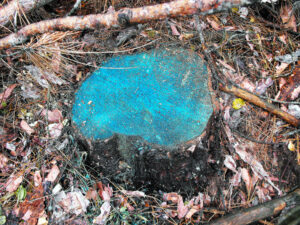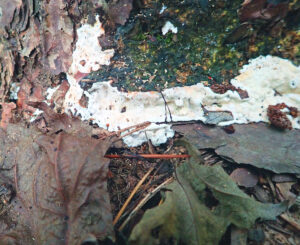
A freshly cut tree stump after treatment with fungicide to prevent infection with Heterobasidion root disease. The fungicide is dyed blue to help ensure complete coverage. / Photo Credit: Wisconsin DNR
By Tim Shively, DNR Forest Health Specialist, Eau Claire
Timothy.Shively@wisconsin.gov or 608-772-6974
Treating freshly cut conifer stumps is critical to preventing infection by Heterobasidion species, causal agents of Heterobasidion root disease (HRD).
Within this genus, H. irregulare is believed to be the only species in Wisconsin, and it causes the mortality of overstory pine and spruce trees. The DNR has developed comprehensive guidelines to assist landowners, property managers, foresters, and loggers with determining whether stump treatments are necessary to prevent the introduction or spread of HRD at a given site.
Cellu-Treat® is currently the only pesticide option available to protect stumps now that Rotstop®C is no longer available for purchase in the United States.
Mechanism Of Infection

A flat fruit body of Heterobasidion root disease grows on the ground line. / Photo Credit: Wisconsin DNR
To understand the mechanisms by which preventative treatments work, it’s important to review the biology of HRD.
Primary infection is the term describing colonization of the first host on a new site. This often occurs when a fungal spore lands on a freshly cut stump. It can then germinate and grow into a mycelium (a network of thread-like filaments of fungus).
When the mycelium expands downward into the roots, it can cross into adjacent trees through root contacts and grafts, thus initiating secondary infection. At this point, HRD is difficult to stop. Because of this, we typically cut a buffer around a disease center, assuming that it will spread at a given rate, and nearby trees will succumb in a predictable manner.
HRD also poses a particular challenge because of its adaptability. It can live both by killing live host cells to feed or by feeding on host tissue that has previously died. In the latter state, HRD can survive for many decades in decaying wood, but it does not survive alone in the soil very long without woody tissue.
An untreated, recently thinned pine plantation provides the perfect environment for HRD. The freshly cut stumps are an ideal opportunity for infection as they are unoccupied by competing microorganisms.
Mode Of Action
The purpose of Cellu-Treat® is to prevent primary infection of cut stumps and stop new infection centers from being established. Untreated stumps are susceptible to HRD infection for several weeks after being cut, and HRD spores can be carried hundreds of miles or more on wind and air currents, although most spores land, and primary infections occur, much closer to the source conk(s) the spores are released from.
While we worry most about exposed, recently cut stumps, the spores can also remain viable after landing on other surfaces (e.g., bark, logging equipment, etc.), and can then conceivably be transferred to a freshly cut surface during forestry operations.
So, how do stump treatments work? The active ingredient in Cellu-Treat® is disodium octaborate terahydrate, a particular form of borate (a different form is used in the familiar product Borax). When applied at a concentration of at least 3 percent (more commonly 5 percent), borate penetrates the stump within minutes and acts as a chemical deterrent to HRD colonization. Borate concentrations fade over a few months during which fungi better able to tolerate the borate colonize the stump, providing another layer of protection from HRD infection.
Efficacy
Borates have been shown to be a consistent and effective treatment to prevent HRD infection with an average efficacy estimation of approximately 80 percent across many studies.
Proper application rates and timing are critical to achieving desired results. The Cellu-Treat® label will provide the appropriate application rate. Application should occur as soon as possible after cutting, within 24 hours. Adding a dye to the mix helps ensure all stumps are treated and coverage is adequate.
